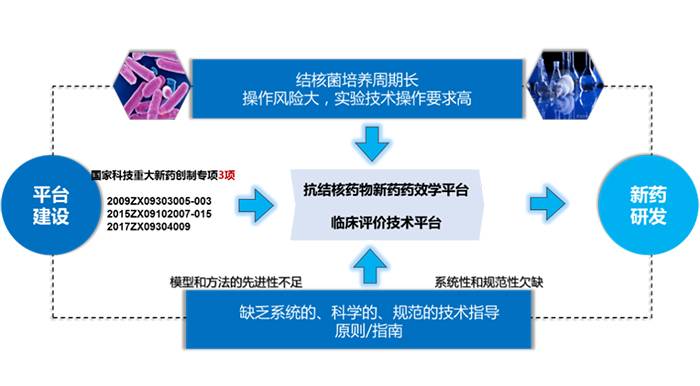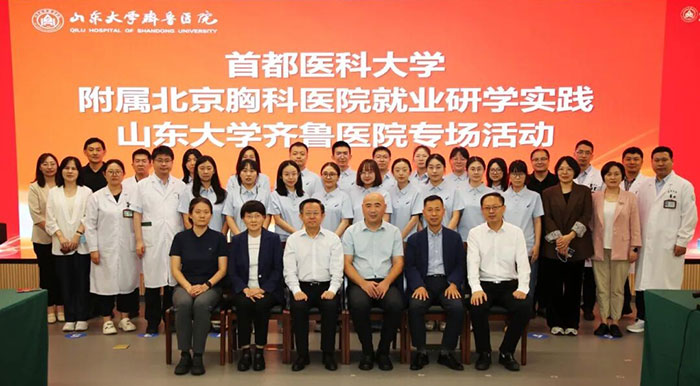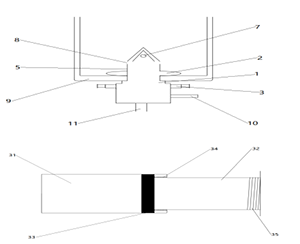2024年
No.7
PubMed
(tuberculosis[Title/Abstract]) OR (lung cancer[Title/Abstract])
Filters applied: from 2024/7/1 - 2024/7/31.
1. Nature. 2024 Jul;631(8020):409-414. doi: 10.1038/s41586-024-07605-8. Epub 2024 Jul 3.
Inhibition of M. tuberculosis and human ATP synthase by BDQ and TBAJ-587.
Zhang Y(#)(1), Lai Y(#)(1), Zhou S(1), Ran T(2), Zhang Y(1), Zhao Z(1), Feng Z(1), Yu L(1), Xu J(1), Shi K(1), Wang J(1), Pang Y(3), Li L(3), Chen H(2), Guddat LW(4), Gao Y(5), Liu F(6), Rao Z(7)(8)(9)(10), Gong H(11).
Author information:
(1)State Key Laboratory of Medicinal Chemical Biology and College of Life Sciences, Nankai University, Tianjin, China.
(2)Innovative Center for Pathogen Research, Guangzhou National Laboratory, Guangzhou, China.
(3)Beijing Chest Hospital, Beijing Tuberculosis and Thoracic Tumor Research Institute, Capital Medical University, Beijing, China.
(4)School of Chemistry and Molecular Biosciences, University of Queensland, Brisbane, Queensland, Australia.
(5)Shanghai Institute for Advanced Immunochemical Studies and School of Life Science and Technology, ShanghaiTech University, Shanghai, China. gaoyan@shanghaitech.edu.cn.
(#)Contributed equally
Bedaquiline (BDQ), a first-in-class diarylquinoline anti-tuberculosis drug, and its analogue, TBAJ-587, prevent the growth and proliferation of Mycobacterium tuberculosis by inhibiting ATP synthase1,2. However, BDQ also inhibits human ATP synthase3. At present, how these compounds interact with either M. tuberculosis ATP synthase or human ATP synthase is unclear. Here we present cryogenic electron microscopy structures of M. tuberculosis ATP synthase with and without BDQ and TBAJ-587 bound, and human ATP synthase bound to BDQ. The two inhibitors interact with subunit a and the c-ring at the leading site, c-only sites and lagging site in M. tuberculosis ATP synthase, showing that BDQ and TBAJ-587 have similar modes of action. The quinolinyl and dimethylamino units of the compounds make extensive contacts with the protein. The structure of human ATP synthase in complex with BDQ reveals that the BDQ-binding site is similar to that observed for the leading site in M. tuberculosis ATP synthase, and that the quinolinyl unit also interacts extensively with the human enzyme. This study will improve researchers' understanding of the similarities and differences between human ATP synthase and M. tuberculosis ATP synthase in terms of the mode of BDQ binding, and will allow the rational design of novel diarylquinolines as anti-tuberculosis drugs.
© 2024. The Author(s), under exclusive licence to Springer Nature Limited.
DOI: 10.1038/s41586-024-07605-8
PMID: 38961288 [Indexed for MEDLINE]
2. J Thorac Oncol. 2024 Jul 24:S1556-0864(24)00683-X. doi:10.1016/j.jtho.2024.07.014. Online ahead of print.
Second Primary Lung Cancer - An Emerging Issue in Lung Cancer Survivors.
Jensen SØ(1), Moore DA(2), Surani AA(1), Crosbie PAJ(3), Rosenfeld N(4), Rintoul RC(5).
Author information:
(1)Cancer Research UK Cambridge Institute, University of Cambridge, Cambridge, United Kingdom; Cancer Research UK Cambridge Centre, University of Cambridge, Cambridge, United Kingdom.
(2)Department of Cellular Pathology, University College Hospital, London United Kingdom; Cancer Research UK Lung Cancer Centre of Excellence, University College London Cancer Institute, London, United Kingdom.
(3)Division of Immunology, Immunity and Infection and Respiratory Medicine, University of Manchester, Manchester, United Kingdom.
(4)Cancer Research UK Cambridge Institute, University of Cambridge, Cambridge, United Kingdom; Barts Cancer Institute, Queen Mary University of London, London, United Kingdom.
(5)Cancer Research UK Cambridge Institute, University of Cambridge, Cambridge, United Kingdom; Cancer Research UK Cambridge Centre, University of Cambridge, Cambridge, United Kingdom; Department of Oncology, University of Cambridge, Cambridge, United Kingdom; Department of Thoracic Oncology, Royal Papworth Hospital, Cambridge, United Kingdom. Electronic address: rcr39@cam.ac.uk.
As a result of an increased focus on early detection including lung cancer screening, combined with more curative treatment options, the 5-year survival rates for lung cancer are improving. Welcome though this is, it brings new, hitherto unseen challenges. As more patients are cured and survive longer, they are at risk of developing second primary cancers, particularly lung cancer. In this review, we examine the challenges that surveillance, diagnosis, and management of second primary lung cancer (SPLC) bring and how these can be addressed. Recent data from prospective follow-up studies suggests that the incidence of SPLC may be higher than previously appreciated, partly due to an increase in multi-focal adenocarcinoma spectrum disease. Over 5 years, up to 1 in 6 long-term lung cancer survivors may develop a SPLC. Although not routinely used in clinical practice at present, genomic approaches for differentiating SPLC from intrapulmonary metastases of the first primary are emerging, and we highlight how this could be used to help differentiate lesions. An accurate distinction between SPLC and the recurrence of the first primary is of paramount importance due to the very different management strategies that may be required. Wrongly classifying an SPLC as a recurrence of the first primary may have significant consequences for patient management and overall survival. Updated approaches to the classification of SPLC combining clinical history, histopathological assessment, and genomic profiling are needed. Finally, we review the potential role of early detection biomarkers in the identification of SPLC, focusing in particular on blood-based biomarkers that are being examined in a multi-center prospective study recruiting lung cancer survivors.
DOI: 10.1016/j.jtho.2024.07.014
PMID: 39059487
3. Nat Rev Gastroenterol Hepatol. 2024 Jul;21(7):517-527. doi:10.1038/s41575-024-00907-2. Epub 2024 Mar 13.
Screening for liver fibrosis: lessons from colorectal and lung cancer screening.
Thiele M(1)(2), Kamath PS(3), Graupera I(4)(5)(6)(7), Castells A(5)(6)(7)(8), de Koning HJ(9), Serra-Burriel M(10), Lammert F(11)(12), Ginès P(13)(14)(15)(16).
Author information:
(1)Centre for Liver Research, Department of Gastroenterology and Hepatology, Odense University Hospital, Odense, Denmark.
(2)Department of Clinical Research, University of Southern Denmark, Odense, Denmark.
(3)Division of Gastroenterology and Hepatology, Mayo Clinic College of Medicine and Science, Rochester, MN, USA.
(4)Liver Unit Hospital Clínic, Barcelona, Catalonia, Spain.
(5)Institut d'Investigacions Biomèdiques August Pi i Sunyer (IDIBAPS), Barcelona, Catalonia, Spain.
Many countries have incorporated population screening programmes for cancer, such as colorectal and lung cancer, into their health-care systems. Cirrhosis is more prevalent than colorectal cancer and has a comparable age-standardized mortality rate to lung cancer. Despite this fact, there are no screening programmes in place for early detection of liver fibrosis, the precursor of cirrhosis. In this Perspective, we use insights from colorectal and lung cancer screening to explore the benefits, challenges, implementation strategies and pathways for future liver fibrosis screening initiatives. Several non-invasive methods and referral pathways for early identification of liver fibrosis exist, but in addition to accurate detection, screening programmes must also be cost-effective and demonstrate benefit through a reduction in liver-related mortality. Randomized controlled trials are needed to confirm this. Future randomized screening trials should evaluate not only the screening tests, but also interventions used to halt disease progression in individuals identified through screening.
DOI: 10.1038/s41575-024-00907-2
PMID: 38480849 [Indexed for MEDLINE]
4. J Thorac Oncol. 2024 Jul;19(7):1028-1051. doi: 10.1016/j.jtho.2024.03.015. Epub 2024 Mar 18.
The International Association for the Study of Lung Cancer (IASLC) Staging Project for Lung Cancer: Recommendation to Introduce Spread Through Air Spaces as a Histologic Descriptor in the Ninth Edition of the TNM Classification of Lung Cancer. Analysis of 4061 Pathologic Stage I NSCLC.
Travis WD(1), Eisele M(2), Nishimura KK(2), Aly RG(3), Bertoglio P(4), Chou TY(5), Detterbeck FC(6), Donnington J(7), Fang W(8), Joubert P(9), Kernstine K(10), Kim YT(11), Lievens Y(12), Liu H(13), Lyons G(14), Mino-Kenudson M(15), Nicholson AG(16), Papotti M(17), Rami-Porta R(18), Rusch V(19), Sakai S(20), Ugalde P(21), Van Schil P(22), Yang CJ(23), Cilento VJ(2), Yotsukura M(24), Asamura H(25); Members of the International Association for the Study of Lung Cancer Staging and Prognostic Factors Committee, Members of the Advisory Boards, and Participating Institutions of the Lung Cancer Domain.
Author information:
(1)Department of Pathology, Memorial Sloan Kettering Cancer Center, New York, New York. Electronic address: travisw@mskcc.org.
(2)Cancer Research And Biostatistics (CRAB), Seattle, Washington.
(3)Department of Pathology, Memorial Sloan Kettering Cancer Center, New York, New York.
(4)IRCCS Azienda Ospedaliero Universitaria di Bologna, Bologna, Italy.
(5)Department of Pathology and Laboratory Medicine, Taipei, Veterans General Hospital, Taipei, Taiwan.
INTRODUCTION: Spread through air spaces (STAS) consists of lung cancer tumor cells that are identified beyond the edge of the main tumor in the surrounding alveolar parenchyma. It has been reported by meta-analyses to be an independent prognostic factor in the major histologic types of lung cancer, but its role in lung cancer staging is not established.
METHODS: To assess the clinical importance of STAS in lung cancer staging, we evaluated 4061 surgically resected pathologic stage I R0 NSCLC collected from around the world in the International Association for the Study of Lung Cancer database. We focused on whether STAS could be a useful additional histologic descriptor to supplement the existing ones of visceral pleural invasion (VPI) and lymphovascular invasion (LVI).
RESULTS: STAS was found in 930 of 4061 of the pathologic stage I NSCLC (22.9%).
Patients with tumors exhibiting STAS had a significantly worse recurrence-free and overall survival in both univariate and multivariable analyses involving cohorts consisting of all NSCLC, specific histologic types (adenocarcinoma and other NSCLC), and extent of resection (lobar and sublobar). Interestingly, STAS was independent of VPI in all of these analyses.
CONCLUSIONS: These data support our recommendation to include STAS as a histologic descriptor for the Ninth Edition of the TNM Classification of Lung Cancer. Hopefully, gathering these data in the coming years will facilitate a thorough analysis to better understand the relative impact of STAS, LVI, and VPI on lung cancer staging for the Tenth Edition TNM Stage Classification.
DOI: 10.1016/j.jtho.2024.03.015
PMID: 38508515 [Indexed for MEDLINE]
5. J Thorac Oncol. 2024 Jul;19(7):1052-1072. doi: 10.1016/j.jtho.2024.03.021. Epub 2024 Apr 1.
The International Association for the Study of Lung Cancer Lung Cancer Staging Project: Proposals for Revision of the Classification of Residual Tumor After Resection for the Forthcoming (Ninth) Edition of the TNM Classification of Lung Cancer.
Detterbeck FC(1), Ostrowski M(2), Hoffmann H(3), Rami-Porta R(4), Osarogiagbon RU(5), Donnington J(6), Infante M(7), Marino M(8), Marom EM(9), Nakajima J(10), Nicholson AG(11), van Schil P(12), Travis WD(13), Tsao MS(14), Edwards JG(15), Asamura H(16); Members of the Staging and Prognostic Factors Committee and Advisory Boards.
Author information:
(1)Department of Surgery, Yale University School of Medicine, New Haven, Connecticut. Electronic address: frank.detterbeck@yale.edu.
(2)Department of Thoracic Surgery, Medical University of Gdansk, Gdansk, Poland.
(3)Division of Thoracic Surgery, Department of Surgery, Klinikum Rechts der Isar, Technical University of Munich, Munich, Germany.
(4)Department of Thoracic Surgery, Hospital Universitari Mutua Terrassa, University of Barcelona, Terrassa, Barcelona, Spain.
(5)Oncology Research Group, Multidisciplinary Thoracic Oncology Program, Baptist Cancer Center, Memphis, Tennessee.
INTRODUCTION: The goal of surgical resection is to completely remove a cancer; it is useful to have a system to describe how well this was accomplished. This is captured by the residual tumor (R) classification, which is separate from the TNM classification that describes the anatomic extent of a cancer independent of treatment. The traditional R-classification designates as R0 a complete resection, as R1 a macroscopically complete resection but with microscopic tumor at the surgical margin, and as R2 a resection that leaves gross tumor behind. For lung cancer, an additional category encompasses situations in which the presence of residual tumor is uncertain.
METHODS: This paper represents a comprehensive review of evidence regarding these R categories and the descriptors thereof, focusing on studies published after the year 2000 and with adjustment for potential confounders.
RESULTS: Consistent discrimination between complete, uncertain, and incomplete resection is revealed with respect to overall survival. Evidence regarding specific descriptors is generally somewhat limited and only partially consistent; nevertheless, the data suggest retaining all descriptors but with clarifications to address ambiguities.
CONCLUSION: On the basis of this review, the R-classification for the ninth edition of stage classification of lung cancer is proposed to retain the same overall framework and descriptors, with more precise definitions of descriptors. These refinements should facilitate application and further research.
DOI: 10.1016/j.jtho.2024.03.021
PMID: 38569931 [Indexed for MEDLINE]
6. Nat Commun. 2024 Jul 8;15(1):5710. doi: 10.1038/s41467-024-48515-7.
Heterogeneity in lung macrophage control of Mycobacterium tuberculosis is modulated by T cells.
Lai R(1), Williams T(1), Rakib T(1), Lee J(1), Behar SM(2).
Author information:
(1)Department of Microbiology and Physiological Systems, University of Massachusetts Medical School, Worcester, MA, USA.
(2)Department of Microbiology and Physiological Systems, University of Massachusetts Medical School, Worcester, MA, USA. samuel.behar@umassmed.edu.
Update of
bioRxiv. 2023 Dec 01:2023.11.29.569283. doi: 10.1101/2023.11.29.569283.
Following Mycobacterium tuberculosis infection, alveolar macrophages are initially infected but ineffectively restrict bacterial replication. The distribution of M. tuberculosis among different cell types in the lung changes with the onset of T cell immunity when the dominant infected cellular niche shifts from alveolar to monocyte-derived macrophages (MDM). We hypothesize that changes in bacterial distribution among different cell types is driven by differences in T cell recognition of infected cells and their subsequent activation of antimicrobial effector mechanisms. We show that CD4 and CD8 T cells efficiently eliminate M. tuberculosis infection in alveolar macrophages, but they have less impact on suppressing infection in MDM, which may be a bacterial niche. Importantly, CD4 T cell responses enhance MDM recruitment to the lung. Thus, the outcome of infection depends on the interaction between the T cell subset and the infected cell; both contribute to the resolution and persistence of the infection.
DOI: 10.1038/s41467-024-48515-7
PMCID: PMC11231272
PMID: 38977711 [Indexed for MEDLINE]
7. Lancet Infect Dis. 2024 Jul 3:S1473-3099(24)00339-6. doi10.1016/S1473-3099(24)00339-6. Online ahead of print.
The inclusion of children and adolescents in tuberculosis diagnostic development and evaluation-a consensus statement.
Bijker EM(1), Horn L(2), LaCourse S(3), MacLean EL(4), Marais BJ(5), Nicol MP(6), Olbrich L(7), Seddon JA(8), Sutherland JS(9), Song R(10), Zar HJ(11), Jaganath D(12); Child TB Diagnostics Consensus Group.
Author information:
(1)Department of Paediatrics, Oxford Vaccine Group, University of Oxford, Oxford, UK; Department of Paediatrics, Maastricht University Medical Center, MosaKids Children's Hospital, Maastricht, the Netherlands.
(2)Office of Research Integrity, University of Cape Town, Cape Town, South Africa.
(3)Departments of Medicine, Global Health, and Epidemiology, Division of Allergy and Infectious Diseases, University of Washington, Seattle, WA, USA.
(4)National Health and Medical Research Council, Clinical Trials Centre, Faculty of Medicine and Health, University of Sydney, Sydney, NSW, Australia; Sydney Infectious diseases Institute & the WHO Collaborating Centre in Tuberculosis, University of Sydney, Sydney, NSW, Australia.
(5)Sydney Infectious diseases Institute & the WHO Collaborating Centre in Tuberculosis, University of Sydney, Sydney, NSW, Australia.
The diagnosis of paediatric tuberculosis remains a challenge due to the non-specificity of symptoms and the paucibacillary nature of tuberculosis in children. However, in the development of new tuberculosis diagnostics, the unique needs of children and adolescents are rarely considered in the design process, with delays in evaluation and approval. No clear guidance is available on when and how to include children and adolescents in tuberculosis diagnostic development and evaluation. To address this gap, we conducted a Delphi consensus process with 42 stakeholders, including one qualitative and two quantitative rounds. Consensus was achieved on 20 statements, with agreement that the needs and perspectives of children, adolescents, and their caregivers should be incorporated throughout diagnostic design and evaluation. Opportunities exist for the early use of well characterised samples and prospective enrolment of children and adolescents in tuberculosis diagnostic evaluation, with consideration of the type of test, expected benefit, and potential risks. Pathogen-based tests might be initially optimised and assessed in adults and adolescents, but parallel evaluation in children is needed for host-based tests. Late-stage evaluation and implementation studies should examine combination testing and integration into clinical algorithms. The statements support collaboration between developers, researchers, regulators, and users to widen and accelerate the diagnostic pipeline for paediatric tuberculosis.
DOI: 10.1016/S1473-3099(24)00339-6
PMID: 38971177
8. Lancet Infect Dis. 2024 Jul;24(7):726-736. doi: 10.1016/S1473-3099(24)00011-2. Epub 2024 Mar 12.
Prevalence of subclinical pulmonary tuberculosis in adults in community settings: an individual participant data meta-analysis.
Stuck L(1), Klinkenberg E(2), Abdelgadir Ali N(3), Basheir Abukaraig EA(4), Adusi-Poku Y(5).
Author information:
(1)Department of Global Health, Amsterdam University Medical Centers, Amsterdam, Netherlands; Amsterdam Institute for Global Health and Development, Amsterdam, Netherlands.
(2)Department of Global Health, Amsterdam University Medical Centers, Amsterdam, Netherlands.
(3)Global Fund Project Management Unit, International Health, Federal Ministry of Health, Khartoum, Sudan.
(4)Research and Development Centre, Alfjr College for Science and Technology, Khartoum, Sudan.
(5)National Tuberculosis Control Programme, Ghana Health Service, Accra, Ghana.
BACKGROUND: Subclinical pulmonary tuberculosis, which presents without recognisable symptoms, is frequently detected in community screening. However, the disease category is poorly clinically defined. We explored the prevalence of subclinical pulmonary tuberculosis according to different case definitions.
METHODS: We did a one-stage individual participant data meta-analysis of nationally representative surveys that were conducted in countries with high incidence of tuberculosis between 2007 and 2020, that reported the prevalence of pulmonary tuberculosis based on chest x-ray and symptom screening in participants aged 15 years and older. Screening and diagnostic criteria were standardised across the surveys, and tuberculosis was defined by positive Mycobacterium tuberculosis sputum culture. We estimated proportions of subclinical tuberculosis for three case definitions: no persistent cough (ie, duration ≥2 weeks), no cough at all, and no symptoms (ie, absence of cough,
fever, chest pain, night sweats, and weight loss), both unadjusted and adjusted for false-negative chest x-rays and uninterpretable culture results.
FINDINGS: We identified 34 surveys, of which 31 were eligible. Individual participant data were obtained and included for 12 surveys (620 682 participants) across eight countries in Africa and four in Asia. Data on 602 863 participants were analysed, of whom 1944 had tuberculosis. The unadjusted proportion of subclinical tuberculosis was 59·1% (n=1149/1944; 95% CI 55·8-62·3) for no persistent cough and 39·8% (773/1944; 36·6-43·0) for no cough of any duration. The adjusted proportions were 82·8% (95% CI 78·6-86·6) for no persistent cough and 62·5% (56·6-68·7) for no cough at all. In a subset of four surveys, the proportion of participants with tuberculosis but without any symptoms was 20·3% (n=111/547; 95% CI 15·5-25·1) before adjustment and 27·7%
(95% CI 21·0-36·4) after adjustment. Tuberculosis without cough, irrespective of its duration, was more frequent among women (no persistent cough: adjusted odds ratio 0·79, 95% CI 0·63-0·97; no cough: adjusted odds ratio 0·76, 95% CI 0·62-0·93). Among participants with tuberculosis, 29·1% (95% CI 25·2-33·3) of those without persistent cough and 23·1% (18·8-27·4) of those without any cough had positive smear examinations.
INTERPRETATION: The majority of people in the community who have pulmonary tuberculosis do not report cough, a quarter report no tuberculosis-suggestive symptoms at all, and a quarter of those not reporting any cough have positive sputum smears, suggesting infectiousness. In high-incidence settings, subclinical tuberculosis could contribute considerably to the tuberculosis burden and to Mycobacterium tuberculosis transmission.
DOI: 10.1016/S1473-3099(24)00011-2
PMID: 38490237 [Indexed for MEDLINE]
9. Lancet Infect Dis. 2024 Jul;24(7):698-725. doi: 10.1016/S1473-3099(24)00007-0. Epub 2024 Mar 19.
Global, regional, and national age-specific progress towards the 2020 milestones of the WHO End TB Strategy: a systematic analysis for the Global Burden of Disease Study 2021.
GBD 2021 Tuberculosis Collaborators.
BACKGROUND: Global evaluations of the progress towards the WHO End TB Strategy 2020 interim milestones on mortality (35% reduction) and incidence (20% reduction) have not been age specific. We aimed to assess global, regional, and national-level burdens of and trends in tuberculosis and its risk factors across five separate age groups, from 1990 to 2021, and to report on age-specific progress between 2015 and 2020.
METHODS: We used the Global Burden of Diseases, Injuries, and Risk Factors Study
2021 (GBD 2021) analytical framework to compute age-specific tuberculosis mortality and incidence estimates for 204 countries and territories (1990-2021 inclusive). We quantified tuberculosis mortality among individuals without HIV co-infection using 22 603 site-years of vital registration data, 1718 site-years of verbal autopsy data, 825 site-years of sample-based vital registration data, 680 site-years of mortality surveillance data, and 9 site-years of minimally invasive tissue sample (MITS) diagnoses data as inputs into the Cause of Death Ensemble modelling platform. Age-specific HIV and tuberculosis deaths were established with a population attributable fraction approach. We analysed all available population-based data sources, including prevalence surveys, annual case notifications, tuberculin surveys, and tuberculosis mortality, in DisMod-MR 2.1 to produce internally consistent age-specific estimates of tuberculosis incidence, prevalence, and mortality. We also estimated age-specific tuberculosis mortality without HIV co-infection that is attributable to the independent and combined effects of three risk factors (smoking, alcohol use, and diabetes). As a secondary analysis, we examined the potential impact of the COVID-19 pandemic on tuberculosis mortality without HIV co-infection by comparing expected tuberculosis deaths, modelled with trends in tuberculosis deaths from 2015 to 2019 in vital registration data, with observed tuberculosis deaths in 2020 and 2021 for countries with available cause-specific mortality data.
FINDINGS: We estimated 9·40 million (95% uncertainty interval [UI] 8·36 to 10·5) tuberculosis incident cases and 1·35 million (1·23 to 1·52) deaths due to tuberculosis in 2021. At the global level, the all-age tuberculosis incidence rate declined by 6·26% (5·27 to 7·25) between 2015 and 2020 (the WHO End TB strategy evaluation period). 15 of 204 countries achieved a 20% decrease in all-age tuberculosis incidence between 2015 and 2020, eight of which were in western sub-Saharan Africa. When stratified by age, global tuberculosis incidence rates decreased by 16·5% (14·8 to 18·4) in children younger than 5 years, 16·2% (14·2 to 17·9) in those aged 5-14 years, 6·29% (5·05 to 7·70) in those aged 15-49 years, 5·72% (4·02 to 7·39) in those aged 50-69 years, and
8·48% (6·74 to 10·4) in those aged 70 years and older, from 2015 to 2020. Global tuberculosis deaths decreased by 11·9% (5·77 to 17·0) from 2015 to 2020. 17 countries attained a 35% reduction in deaths due to tuberculosis between 2015 and 2020, most of which were in eastern Europe (six countries) and central Europe (four countries). There was variable progress by age: a 35·3% (26·7 to 41·7) decrease in tuberculosis deaths in children younger than 5 years, a 29·5% (25·5 to 34·1) decrease in those aged 5-14 years, a 15·2% (10·0 to 20·2) decrease in those aged 15-49 years, a 7·97% (0·472 to 14·1) decrease in those aged 50-69 years, and a 3·29% (-5·56 to 9·07) decrease in those aged 70 years and older. Removing the combined effects of the three attributable risk factors would have reduced the number of all-age tuberculosis deaths from 1·39 million (1·28 to 1·54) to 1·00 million (0·703 to 1·23) in 2020, representing a 36·5% (21·5 to 54·8) reduction in tuberculosis deaths compared to those observed in 2015. 41 countries were included in our analysis of the impact of the COVID-19 pandemic on tuberculosis deaths without HIV co-infection in 2020, and 20 countries were included in the analysis for 2021. In 2020, 50 900 (95% CI 49 700 to 52 400) deaths were expected across all ages, compared to an observed 45 500 deaths, corresponding to 5340 (4070 to 6920) fewer deaths; in 2021, 39 600 (38 300 to 41 100) deaths were expected across all ages compared to an observed 39 000 deaths, corresponding to 657 (-713 to 2180) fewer deaths.
INTERPRETATION: Despite accelerated progress in reducing the global burden of tuberculosis in the past decade, the world did not attain the first interim milestones of the WHO End TB Strategy in 2020. The pace of decline has been unequal with respect to age, with older adults (ie, those aged >50 years) having the slowest progress. As countries refine their national tuberculosis programmes and recalibrate for achieving the 2035 targets, they could consider learning from the strategies of countries that achieved the 2020 milestones, as well as consider targeted interventions to improve outcomes in older age groups.
DOI: 10.1016/S1473-3099(24)00007-0
PMCID: PMC11187709
PMID: 38518787 [Indexed for MEDLINE]
10. Lancet Glob Health. 2024 Jul;12(7):e1184-e1191. doi: 10.1016/S2214-109X(24)00148-7.
Diagnostic yield as an important metric for the evaluation of novel tuberculosis tests: rationale and guidance for future research.
Broger T(1), Marx FM(2), Theron G(3), Marais BJ(4), Nicol MP(5), Kerkhoff AD(6), Nathavitharana R(7), Huerga H(8), Gupta-Wright A(1), Kohli M(9), Nichols BE(9), Muyoyeta M(10), Meintjes G(11), Ruhwald M(9), Peeling RW(12), Pai NP(13), Pollock NR(14), Pai M(15), Cattamanchi A(16), Dowdy DW(17), Dewan P(18), Denkinger CM(19).
Author information:
(1)Department of Infectious Disease and Tropical Medicine, Heidelberg University Hospital, Heidelberg, Germany.
(2)Department of Infectious Disease and Tropical Medicine, Heidelberg University Hospital, Heidelberg, Germany; DSI-NRF Centre of Excellence in Epidemiological Modelling and Analysis (SACEMA), Faculty of Science, Stellenbosch University, Stellenbosch, South Africa.
(3)DSI-NRF Centre of Excellence for Biomedical Tuberculosis Research, South African Medical Research Council Centre for Tuberculosis Research, Division of Molecular Biology and Human Genetics, Faculty of Medicine and Health Sciences, Stellenbosch University, Cape Town, South Africa.
(4)The University of Sydney Infectious Diseases Institute, Sydney, NSW, Australia; Children's Hospital at Westmead, Sydney, NSW, Australia.
(5)Division of Infection and Immunity, School of Biomedical Sciences, University of Western Australia, Perth, WA, Australia.
Better access to tuberculosis testing is a key priority for fighting tuberculosis, the leading cause of infectious disease deaths in people. Despite the roll-out of molecular WHO-recommended rapid diagnostics to replace sputum smear microscopy over the past decade, a large diagnostic gap remains. Of the estimated 10·6 million people who developed tuberculosis globally in 2022, more than 3·1 million were not diagnosed. An exclusive focus on improving tuberculosis test accuracy alone will not be sufficient to close the diagnostic gap for tuberculosis. Diagnostic yield, which we define as the proportion of people in whom a diagnostic test identifies tuberculosis among all people we attempt to test for tuberculosis, is an important metric not adequately explored. Diagnostic yield is particularly relevant for subpopulations unable to produce sputum such as young children, people living with HIV, and people with subclinical tuberculosis. As more accessible non-sputum specimens (eg, urine, oral swabs, saliva, capillary blood, and breath) are being explored for point-of-care tuberculosis testing, the concept of yield will be of growing importance. Using the example of urine lipoarabinomannan testing, we illustrate how even tests with limited sensitivity can diagnose more people with tuberculosis if they enable increased diagnostic yield. Using tongue swab-based molecular tuberculosis testing as another example, we provide definitions and guidance for the design and conduct of pragmatic studies that assess diagnostic yield. Lastly, we show how diagnostic yield and other important test characteristics, such as cost and implementation feasibility, are essential for increased effective population coverage, which is required for optimal clinical care and transmission impact. We are calling for diagnostic yield to be incorporated into tuberculosis test evaluation processes, including the WHO Grading of Recommendations, Assessment, Development, and Evaluations process, providing a crucial real-life implementation metric that complements traditional
accuracy measures.
DOI: 10.1016/S2214-109X(24)00148-7
PMID: 38876764 [Indexed for MEDLINE]
11. J Infect. 2024 Sep;89(3):106231. doi: 10.1016/j.jinf.2024.106231. Epub 2024 Jul 18.
Disseminated tuberculosis is associated with impaired T cell immunity mediated by non-canonical NF-κB pathway.
Jiang J(1), Cao Z(2), Li B(1), Ma X(1), Deng X(3), Yang B(2), Liu Y(2), Zhai F(2), Cheng X(4).
Author information:
(1)Institute of Research, Beijing Key Laboratory of Organ Transplantation and Immune Regulation, Senior Department of Respiratory and Critical Care Medicine, the Eighth Medical Center of PLA General Hospital, Beijing, China.
(2)Beijing Key Laboratory of New Techniques of Tuberculosis Diagnosis and Treatment, Institute of Tuberculosis Research, Senior Department of Tuberculosis, the Eighth Medical Center of PLA General Hospital, Beijing, China.
(3)Department of Laboratory Medicine, the Eighth Medical Center of PLA General Hospital, Beijing, China.
(4)Beijing Key Laboratory of New Techniques of Tuberculosis Diagnosis and Treatment, Institute of Tuberculosis Research, Senior Department of Tuberculosis, the Eighth Medical Center of PLA General Hospital, Beijing, China.
Electronic address: xcheng2@139.com.
OBJECTIVES: The mechanism that leads to disseminated tuberculosis in HIV-negative patients is still largely unknown. T cell subsets and signaling pathways that were associated with disseminated tuberculosis were investigated.
METHODS: Single-cell profiling of whole T cells was performed to identify T cell subsets and enriched signaling pathways that were associated with disseminated tuberculosis. Flow cytometric analysis and blocking experiment were used to investigate the findings obtained by transcriptome sequencing.
RESULTS: Patients with disseminated tuberculosis had depleted Th1, Tc1 and Tc17 cell subsets, and IFNG was the most down-regulated gene in both CD4 and CD8 T cells. Gene Ontology analysis showed that non-canonical NF-κB signaling pathway, including NFKB2 and RELB genes, was significantly down-regulated and was probably associated with disseminated tuberculosis. Expression of several TNF superfamily ligands and receptors, such as LTA and TNF genes, were suppressed in patients with disseminated tuberculosis. Blocking of TNF-α and soluble LTα showed that TNF-α was involved in IFN-γ production and LTα influenced TNF-α expression in T cells.
CONCLUSIONS: Impaired T cell IFN-γ response mediated by suppression of TNF and non-canonical NF-κB signaling pathways might be responsible for disseminated tuberculosis.
DOI: 10.1016/j.jinf.2024.106231
PMID: 39032519 [Indexed for MEDLINE]
12. Adv Mater. 2024 Jul 28:e2406143. doi: 10.1002/adma.202406143. Online ahead of print.
NIR-II AIE Luminogen-Based Erythrocyte-Like Nanoparticles with Granuloma-Targeting and Self-Oxygenation Characteristics for Combined Phototherapy of Tuberculosis.
Wang H(1)(2), Li B(3), Sun Y(4), Ma Q(1), Feng Y(5), Jia Y(3), Wang W(5), Su M(3), Liu X(3), Shu B(5), Zheng J(5), Sang S(3), Yan Y(5), Wu Y(5), Zhang Y(5), Gao Q(2), Li P(5), Wang J(5), Ma F(3), Li X(5), Yan D(4), Wang D(4), Zou X(1), Liao Y(2)(3).
Author information:
(1)The Seventh Affiliated Hospital, Southern Medical University, Foshan, Guangdong, 528200, China.
(2)Institute for Engineering Medicine, Kunming Medical University, Kunming, Yunnan, 650500, China.
(3)School of Inspection, Ningxia Medical University, Yinchuan, Ningxia, 750004, China.
(4)Center for AIE Research, Shenzhen Key Laboratory of Polymer Science and Technology, Guangdong Research Center for Interfacial Engineering of Functional Materials, College of Materials Science and Engineering, Shenzhen University,
Shenzhen, Guangdong, 518060, China.
(5)Molecular Diagnosis and Treatment Center for Infectious Diseases, Dermatology Hospital of Southern Medical University, Guangzhou, Guangdong, 516006, China.
Tuberculosis, a fatal infectious disease caused by Mycobacterium tuberculosis (M.tb), is difficult to treat with antibiotics due to drug resistance and short drug half-life. Phototherapy represents a promising alternative to antibiotics in combating M.tb. Exploring an intelligent material allowing effective tuberculosis treatment is definitely appealing, yet a significantly challenging task. Herein, an all-in-one biomimetic therapeutic nanoparticle featured by aggregation-induced second near-infrared emission, granuloma-targeting, and self-oxygenation is constructed, which can serve for prominent fluorescence imaging-navigated combined phototherapy toward tuberculosis. After camouflaging the biomimetic erythrocyte membrane, the nanoparticles show significantly prolonged blood circulation and increased selective accumulation in tuberculosis granuloma. Upon laser irradiation, the loading photosensitizer of aggregation-induced emission photosensitizer elevates the production of reactive oxygen species (ROS), causing M.tb damage and death. The delivery of oxygen to relieve the hypoxic granuloma microenvironment supports ROS generation during photodynamic therapy. Meanwhile, the photothermal agent, Prussian blue nanoparticles, plays the role of good photothermal killing effect on M.tb. Moreover, the growth and proliferation of granuloma and M.tb colonies are effectively inhibited in the nanoparticle-treated tuberculous granuloma model mice, suggesting the combined therapeutic effects of enhancing photodynamic therapy and photothermal therapy.
DOI: 10.1002/adma.202406143
PMID: 39072892
13. Nat Commun. 2024 Jul 9;15(1):5740. doi: 10.1038/s41467-024-50051-3.
The mycobacterial glycoside hydrolase LamH enables capsular arabinomannan release and stimulates growth.
Franklin A(1), Salgueiro VC(2), Layton AJ(1), Sullivan R(1), Mize T(1), Vázquez-Iniesta L(2), Benedict ST(1), Gurcha SS(1), Anso I(3), Besra GS(1), Banzhaf M(1), Lovering AL(1), Williams SJ(4), Guerin ME(5), Scott NE(6), Prados-Rosales R(2), Lowe EC(7), Moynihan PJ(8).
Author information:
(1)School of Biosciences, University of Birmingham, Birmingham, UK.
(2)Department of Preventive Medicine, Public Health and Microbiology, School of Medicine, Universidad Autonoma de Madrid, Madrid, Spain.
(3)Structural Glycobiology Laboratory, Department of Structural and Molecular Biology, Molecular Biology Institute of Barcelona, Spanish National Research Council, Barcelona Science Park, c/Baldiri Reixac 10-12, Tower R, 08028, Barcelona, Catalonia, Spain.
(4)School of Chemistry and Bio21 Molecular Science and Biotechnology Institute, University of Melbourne, Parkville, VIC, Australia.
(5)Structural Glycobiology Laboratory, Department of Structural and Molecular Biology; Molecular Biology Institute of Barcelona (IBMB), Spanish National Research Council (CSIC), Barcelona, Catalonia, Spain.
Update of
bioRxiv. 2023 Oct 26:2023.10.26.563968. doi: 10.1101/2023.10.26.563968.
Mycobacterial glycolipids are important cell envelope structures that drive host-pathogen interactions. Arguably, the most important are lipoarabinomannan (LAM) and its precursor, lipomannan (LM), which are trafficked from the bacterium to the host via unknown mechanisms. Arabinomannan is thought to be a capsular derivative of these molecules, lacking a lipid anchor. However, the mechanism by which this material is generated has yet to be elucidated. Here, we describe the identification of a glycoside hydrolase family 76 enzyme that we term LamH (Rv0365c in Mycobacterium tuberculosis) which specifically cleaves α-1,6-mannoside linkages within LM and LAM, driving its export to the capsule releasing its phosphatidyl-myo-inositol mannoside lipid anchor. Unexpectedly, we found that the catalytic activity of this enzyme is important for efficient exit from stationary phase cultures, potentially implicating arabinomannan as a signal for growth phase transition. Finally, we demonstrate that LamH is important for M. tuberculosis survival in macrophages.
DOI: 10.1038/s41467-024-50051-3
PMCID: PMC11233589
PMID: 38982040 [Indexed for MEDLINE]
14. Nucleic Acids Res. 2024 Jul 22;52(13):7876-7892. doi: 10.1093/nar/gkae338.
A novel regulatory interplay between atypical B12 riboswitches and uORF translation in Mycobacterium tuberculosis.
Kipkorir T(1), Polgar P(1), Barker D(1), D'Halluin A(1), Patel Z(1), Arnvig KB(1).
Author information:
(1)Institute for Structural and Molecular Biology, University College London, Gower Street, WC1E 6BT London, UK.
Vitamin B12 is an essential cofactor in all domains of life and B12-sensing riboswitches are some of the most widely distributed riboswitches. Mycobacterium tuberculosis, the causative agent of tuberculosis, harbours two B12-sensing riboswitches. One controls expression of metE, encoding a B12-independent methionine synthase, the other controls expression of ppe2 of uncertain function. Here, we analysed ligand sensing, secondary structure and gene expression control of the metE and ppe2 riboswitches. Our results provide the first evidence of B12 binding by these riboswitches and show that they exhibit different preferences for individual isoforms of B12, use distinct regulatory and structural elements and act as translational OFF switches. Based on our results, we propose that the ppe2 switch represents a new variant of Class IIb B12-sensing riboswitches. Moreover, we have identified short translated open reading frames (uORFs) upstream of metE and ppe2, which modulate the expression of their downstream genes. Translation of the metE uORF suppresses MetE expression, while translation of the ppe2 uORF is essential for PPE2 expression. Our findings reveal an unexpected regulatory interplay between B12-sensing riboswitches and the translational machinery, highlighting a new level of cis-regulatory complexity in M. tuberculosis. Attention to such mechanisms will be critical in designing next-level intervention strategies.
DOI: 10.1093/nar/gkae338
PMCID: PMC11260477
PMID: 38709884 [Indexed for MEDLINE]
15. Angew Chem Int Ed Engl. 2024 Jul 9:e202408473. doi: 10.1002/anie.202408473. Online ahead of print.
N-Phenyl-2-Pyridone-Derived Endoperoxide Suppressing both Lung Cancer and Idiopathic Pulmonary Fibrosis Progression by Three-Pronged Action.
Wang L(1), Wu H(1), Liu Z(1), Sun R(1), Li Y(1), Si Y(1), Nie Y(1), Qiao Y(1), Qian X(1), Zhang S(1), Sun W(1), Pan Y(1), Akkaya EU(2), Li G(1).
Author information:
(1)Dalian University of Technology, State Key Laboratory of Fine Chemicals, CHINA.
(2)Dalian University of Technology, 2 Linggong Road,, 116024, Dalian, CHINA.
We report an endoperoxide compound (E5) which can deliver three therapeutic components by a thermal cycloreversion, namely, singlet oxygen, triplet oxygen and 3-methyl-N-phenyl-2-pyridone, thus targeting multiple mechanisms for treating non-small cell lung cancer and idiopathic pulmonary fibrosis. In aqueous environment, E5 undergoes clean reaction to afford three therapeutic components with a half-life of 8.3 hours without the generation of other by-products, which not only achieves good cytotoxicity toward lung cancer cells and decreases the levels of HIF-1α protein, but also inhibits the TGF-β1 induced fibrosis in vitro. In vivo experiments also demonstrated the efficacy of E5 in inhibiting tumor growth and relieving idiopathic pulmonary fibrosis, while exhibiting good biocompatibility. Many lines of evidence reveal the therapeutic efficacy of singlet oxygen and 3-methyl-N-phenyl-2-pyridone, and triplet oxygen could downregulate HIF-1α and relieve tumor hypoxia which is a critical issue in conventional PDT. Unlike other combination therapies, in which multiple therapeutic agents are given in independent formulations, our work demonstrates single molecule endoperoxide prodrugs could be developed as new platforms for treatment of cancers and related diseases.
DOI: 10.1002/anie.202408473
PMID: 38979839
16. Int J Surg. 2024 Jul 11. doi: 10.1097/JS9.0000000000001921. Online ahead of print.
Salvage surgery and conversion surgery for patients with non-small cell lung cancer: A narrative review.
Yan HJ(1)(2), Zheng XY(1), Zeng YT(3), Wan JX(3), Chen J(3), Deng ZQ(4), Mao YY(3), Hu WL(3), Zhang JJ(4), Zhong AL(4), Zhao CY(5), Mao WJ(6), Tian D(1).
Author information:
(1)Department of Thoracic Surgery, West China Hospital, Sichuan University, Chengdu 610041, China.
(2)Department of General Thoracic Surgery, Juntendo University School of Medicine, Tokyo 113-8431, Japan.
(3)School of Clinical Medicine, North Sichuan Medical College, Nanchong 637000, China.
(4)School of Medical Imaging, North Sichuan Medical College, Nanchong 637000, China.
(5)Department of Nuclear Medicine, West China Hospital, Sichuan University, Chengdu 610041, China.
Non-small cell lung cancer (NSCLC) remains the leading cause of cancer-related deaths. With the development of screening, patient selection and treatment strategies, patients' survival outcomes and living quality significantly improved. However, some patients still have local recurrence or residual tumors after receiving definitive therapies. Salvage surgery has been regarded as an effective option for recurrent or residual NSCLC, but its effectiveness remains undetermined. Furthermore, conversion surgery is a special type of salvage surgery for tumors converted from "initially unresectable" to "potentially resectable" status due to a favorable response to systemic treatments. Although conversion surgery is a promising curative procedure for advanced NSCLC, its concept and clinical value remain unfamiliar to clinicians. In this narrative review, we provided an overview of the safety and efficacy of salvage surgery, especially salvage surgery after sublobar resection in early-stage NSCLC. More importantly, we highlighted the concept and value of conversion surgery aftersystemic treatment in advanced NSCLC to gain some insights into its role in the
treatment of lung cancer.
DOI: 10.1097/JS9.0000000000001921
PMID: 38990285
17. Nat Commun. 2024 Jul 12;15(1):5857. doi: 10.1038/s41467-024-50157-8.
Glucose-6-phosphate dehydrogenase maintains redox homeostasis and biosynthesis in LKB1-deficient KRAS-driven lung cancer.
Lan T(1), Arastu S(1), Lam J(1), Kim H(1), Wang W(1), Wang S(1), Bhatt V(1), Lopes EC(1)(2), Hu Z(1), Sun M(1), Luo X(1), Ghergurovich JM(3), Su X(1)(4), Rabinowitz JD(1)(5)(6)(7), White E(1)(2)(6), Guo JY(8)(9)(10).
Author information:
(1)Rutgers Cancer Institute, New Brunswick, NJ, 08901, USA.
(2)Department of Molecular Biology and Biochemistry, Rutgers University, Piscataway, NJ, 08854, USA.
(3)Department of Molecular Biology, Princeton University, Princeton, NJ, 08544, USA.
(4)Department of Medicine, Rutgers Robert Wood Johnson Medical School, New Brunswick, NJ, 08901, USA.
(5)Department of Chemistry, Princeton University, Princeton, NJ, 08544, USA.
Cancer cells depend on nicotinamide adenine dinucleotide phosphate (NADPH) to combat oxidative stress and support reductive biosynthesis. One major NADPH production route is the oxidative pentose phosphate pathway (committed step: glucose-6-phosphate dehydrogenase, G6PD). Alternatives exist and can compensate in some tumors. Here, using genetically-engineered lung cancer mouse models, we show that G6PD ablation significantly suppresses KrasG12D/+;Lkb1-/- (KL) but not KrasG12D/+;P53-/- (KP) lung tumorigenesis. In vivo isotope tracing and metabolomics reveal that G6PD ablation significantly impairs NADPH generation, redox balance, and de novo lipogenesis in KL but not KP lung tumors. Mechanistically, in KL tumors, G6PD ablation activates p53, suppressing tumor growth. As tumors progress, G6PD-deficient KL tumors increase an alternative NADPH source from serine-driven one carbon metabolism, rendering associated tumor-derived cell lines sensitive to serine/glycine depletion. Thus, oncogenic driver mutations determine lung cancer dependence on G6PD, whose targeting is a potential therapeutic strategy for tumors harboring KRAS and LKB1 co-mutations.
DOI: 10.1038/s41467-024-50157-8
PMCID: PMC11245543
PMID: 38997257 [Indexed for MEDLINE]
18. Lancet Glob Health. 2024 Jul;12(7):e1139-e1148. doi: 10.1016/S2214-109X(24)00178-5.
Trade-offs between clinical performance and test accessibility in tuberculosis diagnosis: a multi-country modelling approach for target product profile development.
Nooy A(1), Ockhuisen T(1), Korobitsyn A(2), Khan SA(3), Ruhwald M(3), Ismail
N(2), Kohli M(3), Nichols BE(4).
Author information:
(1)Department of Global Health, Amsterdam Institute for Global Health and Development, Amsterdam UMC, University of Amsterdam, Amsterdam, Netherlands.
(2)World Health Organization, Geneva, Switzerland.
(3)FIND, Geneva, Switzerland.
(4)Department of Global Health, Amsterdam Institute for Global Health and Development, Amsterdam UMC, University of Amsterdam, Amsterdam, Netherlands; FIND, Geneva, Switzerland; Department of Global Health, Boston University School of Public Health, Boston, MA, USA. Electronic address:
brooke.nichols@finddx.org.
BACKGROUND: Tuberculosis continues to be a leading cause of infectious disease mortality, and effective screening and diagnosis remains crucial. Despite progress made, diagnostic gaps remain due to poor access to diagnostic tools and testing, particularly in rural and remote areas. As such, the development of target product profiles is essential in guiding the development of new diagnostic tools, however target product profiles often lack evidence-based information and do not consider trade-offs between test accuracy and accessibility.
METHODS: A simulation-based model, in the form of a decision tree, was used to map out the baseline patient tuberculosis diagnostic pathway for individuals in Kenya, South Africa, and India. The model was then used to adapt this pathway to evaluate the trade-offs between increased access to testing and varying accuracy of new tuberculosis diagnostic tools within the health-care contexts of Kenya, South Africa, and India. The model aims to support target product profile development by quantifying the impact of new diagnostics on the standard of care. The model considered three diagnostic attributes, namely sample type (sputum vs non-sputum), site of testing (point of care, near point of care, and health setting) and turnaround time.
FINDINGS: Our results indicate that per sample type, novel point-of-care tests would be the most accessible and even with lower sensitivities can achieve comparable or better case detection than the current standard of care in each country. Non-sputum diagnostics also have lower sensitivity requirements. Overall, target product profile parameters with reduced sensitivities from 70% for non-sputum and 78% for sputum tests could be accepted.
INTERPRETATION: Diagnostics which bring tuberculosis tests and test results closer to the patient could reduce overall diagnostic loss despite potential reductions in sensitivity. This work provides a novel framework for guiding the future development of diagnostics, with an approach towards balancing accessibility and test performance.
FUNDING: The Bill and Melinda Gates Foundation (INV-045721).
DOI: 10.1016/S2214-109X(24)00178-5
PMID: 38876761 [Indexed for MEDLINE]
19. Adv Sci (Weinh). 2024 Jul 22:e2401077. doi: 10.1002/advs.202401077. Online ahead of print.
Mitochondrial Transplantation Promotes Protective Effector and Memory CD4(+) T Cell Response During Mycobacterium Tuberculosis Infection and Diminishes Exhaustion and Senescence in Elderly CD4(+) T cells.
Headley CA(1)(2)(3), Gautam S(1), Olmo-Fontanez A(4)(5), Garcia-Vilanova A(4), Dwivedi V(1), Schami A(4), Weintraub S(6), Tsao PS(3), Torrelles JB(4)(7), Turner J(1)(8).
Author information:
(1)Host-Pathogen Interactions Program, Texas Biomedical Research Institute, San Antonio, TX, 78227, USA.
(2)Biomedical Sciences Graduate Program, The Ohio State University, Columbus, OH, 43201, USA.
(3)Stanford Cardiovascular Institute, Stanford University School of Medicine, Stanford, CA, 94305, USA.
(4)Population Health Program, Texas Biomedical Research Institute, San Antonio, TX, 78227, USA.
(5)Southwest National Primate Research Center, Texas Biomedical Research Institute, San Antonio, TX, 78227, USA.
Tuberculosis (TB), caused by Mycobacterium tuberculosis (M.tb), is a major global health concern, particularly affecting those with weakened immune systems, including the elderly. CD4+ T cell response is crucial for immunity against M.tb, but chronic infections and aging can lead to T cell exhaustion and senescence, worsening TB disease. Mitochondrial dysfunction, prevalent in aging and chronic diseases, disrupts cellular metabolism, increases oxidative stress, and impairs T-cell functions. This study investigates the effect of mitochondrial transplantation (mito-transfer) on CD4+ T cell differentiation and function in aged mouse models and human CD4+ T cells from elderly individuals. Mito-transfer in naïve CD4+ T cells is found to promote protective effector and memory T cell generation during M.tb infection in mice. Additionally, it improves elderly human T cell function by increasing mitochondrial mass and altering cytokine production, thereby reducing markers of exhaustion and senescence. These findings suggest mito-transfer as a novel approach to enhance aged CD4+ T cell functionality, potentially benefiting immune responses in the elderly and chronic TB patients. This has broader implications for diseases where mitochondrial dysfunction contributes to T-cell exhaustion and senescence.
DOI: 10.1002/advs.202401077
PMID: 39039808
20. Lancet Glob Health. 2024 Jul;12(7):e1159-e1173. doi: 10.1016/S2214-109X(24)00181-5.
Cost-effectiveness of interventions for HIV/AIDS, malaria, syphilis, and tuberculosis in 128 countries: a meta-regression analysis.
Silke F(1), Earl L(1), Hsu J(1), Janko MM(2), Joffe J(3), Memetova A(1), Michael D(4), Zheng P(5), Aravkin A(6), Murray CJL(1), Weaver MR(7).
Author information:
(1)Institute for Health Metrics and Evaluation, University of Washington, Seattle, WA, USA.
(2)Duke Global Health Institute, Duke University, Durham, NC, USA.
(3)Department of Biostatistics, Epidemiology, and Informatics, Perelman School of Medicine, University of Pennsylvania, Philadelphia, PA, USA.
(4)Shirland Consulting, Seattle, WA, USA.
(5)Department of Health Metric Sciences, School of Medicine, University of Washington, Seattle, WA, USA.
BACKGROUND: Cost-effectiveness analyses have been conducted for many interventions for HIV/AIDS, malaria, syphilis, and tuberculosis, but they have not been conducted for all interventions that are currently recommended in all countries. To support national decision makers in the effective allocation of resources, we conducted a meta-regression analysis of published incremental cost-effectiveness ratios (ICERs) for interventions for these causes, and predicted ICERs for 14 recommended interventions for Global Fund-eligible countries.
METHODS: In the meta-regression analysis, we used data from the Tufts University Center for the Evaluation of Value and Risk in Health (Boston, MA, USA) Cost-Effectiveness Registries (the CEA Registry beginning in 1976 and the Global Health CEA registry beginning in 1995) up to Jan 1, 2018. To create analysis files, we standardised and mapped the data, extracted additional data from published articles, and added variables from the Global Burden of Diseases, Injuries, and Risk Factors Study (GBD). Then we selected ratios for interventions with a minimum of two published articles and three published ICERs that mapped to one of five GBD causes (HIV/AIDS, malaria, syphilis, drug-susceptible tuberculosis, or multi-drug resistant tuberculosis), and to a GBD country; reported a currency year during or after 1990; and for which the
comparator intervention was defined as no intervention, standard of care, or placebo. Our meta-regression analysis used all available data on 25 eligible interventions, and quantified the association between ICERs and factors at country level and intervention level. We used a five-stage statistical model that was developed to synthesise evidence on cost-effectiveness analyses, and we adapted it for smaller sample sizes by grouping interventions by cause and type (ie, prevention, diagnostics, and treatment). Using the meta-regression parameters we predicted country-specific median ICERs, IQRs, and 95% uncertainty intervals in 2019 US$ per disability-adjusted life-year (DALY) for 14 currently recommended interventions. We report ICERs in league tables with gross domestic product (GDP) per capita and country-specific thresholds.
FINDINGS: The sample for the analysis was 1273 ratios from 144 articles, of which we included 612 ICERs from 106 articles in our meta-regression analysis. We predicted ICERs for antiretroviral therapy for prevention for two age groups and pregnant women, pre-exposure prophylaxis against HIV for two risk groups, four malaria prevention interventions, antenatal syphilis screening, two tuberculosis prevention interventions, the Xpert tuberculosis test, and chemotherapy for drug-sensitive tuberculosis. At the country level, ranking of interventions and number of interventions with a predicted median ICER below the country-specific threshold varied greatly. For instance, median ICERs for six of 14 interventions were below the country-specific threshold in Sudan, whereas 12 of 14 were below the country-specific threshold in Peru. Antenatal syphilis
screening had the lowest median ICER among all 14 interventions in 81 (63%) of 128 countries, ranging from $3 (IQR 2-4) per DALY averted in Equatorial Guinea to $3473 (2244-5222) in Ukraine. Pre-exposure prophylaxis for HIV/AIDS for men who have sex with men had the highest median ICER among all interventions in 116 (91%) countries, ranging from $2326 (1077-4567) per DALY averted in Lesotho to $53 559 (23 841-108 534) in Maldives.
INTERPRETATION: Country-specific league tables highlight the interventions that offer better value per DALY averted, and can support decision making at a country level that is more tailored to available resources than GDP per capita and country-specific thresholds. Meta-regression is a promising method to synthesise cost-effectiveness analysis results and transfer them across settings.
DOI: 10.1016/S2214-109X(24)00181-5
PMCID: PMC11194165
PMID: 38876762 [Indexed for MEDLINE]









.jpg)
















